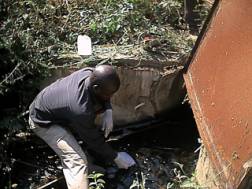The problem
Zambia is a land-locked country in Central/Southern Africa with a population of about 10 million people. About 1.25 million people inhabit the capital, Lusaka, with another 2 million in the northern Copperbelt region. Major pollution-related problems are due to mining and industrial waste. In 2001, Blacksmith Institute helped to found ARE, an NGO focusing on a heavily polluted industrial area on the Kafue River. The Kafue River, part of the Zambezi basin, is a source of potable water for over forty percent of Zambia's population. It is also host to wildlife and birds. For decades, industries such as copper mines, metallurgical plants, textile plants, fertilizer factories, sugar processing plants, cement factories, various agricultural activities, and the Kafue Sewage Treatment Plant (KSTP) have polluted the river. Mineral deposits, chemicals, and suspended solids have led to overgrowth of aquatic weeds, choking river life. The continuous discharge of raw sewage into the Kafue River from the KSTP has contributed to the steady supply of nutrients (ortho-phosphates, nitrates, ammonia, etc.) ensuring the proliferation of various types of weeds, like the Salvina molesta, thereby causing eutrophication. Both aquatic life and human health are in danger. High incidences of environmentally mediated disease, such as gastro-enteritis, intestinal worms, and diarrhea diseases mostly in children have been reported from communities around the river and have been linked to drinking water from certain parts of the river. The raw sewer pollution of Kafue River could inadvertently lead to outbreaks of epidemics like cholera.Bata Tannery uses various chemicals in tanning animal skins. Amongst these chemicals is chromium sulfate, which can easily be converted to either hexavalent or trivalent chromium. The effect of these chemicals on human and aquatic life is potentially lethal. Equally, the yeast production from Lee Yeast results in high concentrations of both chemical oxygen demand (COD) and biochemical oxygen demand (BOD) in the wastewater. The net effect is the reduction in the river system's oxygen concentration, leading to toxic anaerobic conditions.
Health Impact
How can lead affect my health?Scientists use many tests to protect the public from harmful effects of toxic chemicals and to find ways for treating persons who have been harmed.
One way to learn whether a chemical will harm people is to determine how the body absorbs, uses, and releases the chemical. For some chemicals, animal testing may be necessary. Animal testing may also help identify health effects such as cancer or birth defects. Without laboratory animals, scientists would lose a basic method for getting information needed to make wise decisions that protect public health. Scientists have the responsibility to treat research animals with care and compassion. Scientists must comply with strict animal care guidelines because laws today protect the welfare of research animals.
The effects of lead are the same whether it enters the body through breathing or swallowing. The main target for lead toxicity is the nervous system, both in adults and children. Long-term exposure of adults to lead at work has resulted in decreased performance in some tests that measure functions of the nervous system. Lead exposure may also cause weakness in fingers, wrists, or ankles. Lead exposure also causes small increases in blood pressure, particularly in middle-aged and older people. Lead exposure may also cause anemia. At high levels of exposure, lead can severely damage the brain and kidneys in adults or children and ultimately cause death. In pregnant women, high levels of exposure to lead may cause miscarriage. High-level exposure in men can damage the organs responsible for sperm production.
Current Activity
ARE is focusing its efforts on compelling the Kafue Sewage Treatment Plant, the Bata Tannery, Kafue Nitrogen Chemicals, and Lee Yeast to establish cleaner production and waste treatment methods that will minimize harmful discharge into the river. ARE is currently lobbying the Ministry of Local Government and Housing, the National Water and Sanitation Council, and multilateral cooperating partners to bring about a stop to the dumping. Recently, ARE has worked with the local administration and industry to bring about production process improvements in Bata Tannery, such as reduction and reuse of effluent streams and more thorough wastewater treatment.Future Plans: ARE continues to work on advocating for improvements in operation at Kafue Sewage Treatment Plant, in addition to participating in various African networks on water quality. ARE continuously monitors effluent streams from industrial plants.
Outcome
Blacksmith is working with NGOs, the local administration and industry to reduce pollution of the Kafue River from copper mines, metallurgical plants, textile plants, fertilizer factories, sugar processing plants, cement factories, various agricultural activities, and the Kafue Sewage Treatment Plant (KSTP). The Kafue River, part of the Zambezi basin, is a source of potable water for over forty percent of Zambia's population. For decades, Mineral deposits, chemicals, and suspended solids have led to overgrowth of aquatic weeds, choking river life. By helping the coalition to implement the reduction and reuse of effluent streams and more thorough wastewater treatment, the River is on its way to recovery.Data File
Pollutants:
Tannery Waste, Solid Waste, Sewage, PCB, Heavy Metals, Chemicals
Location:
Kabwe,
Zambia
Source:
Tannery Operations, Product Manufacturing, Mining
Report Type:
Project
Project Status:
Success Stories
Pollution Status:
Active


